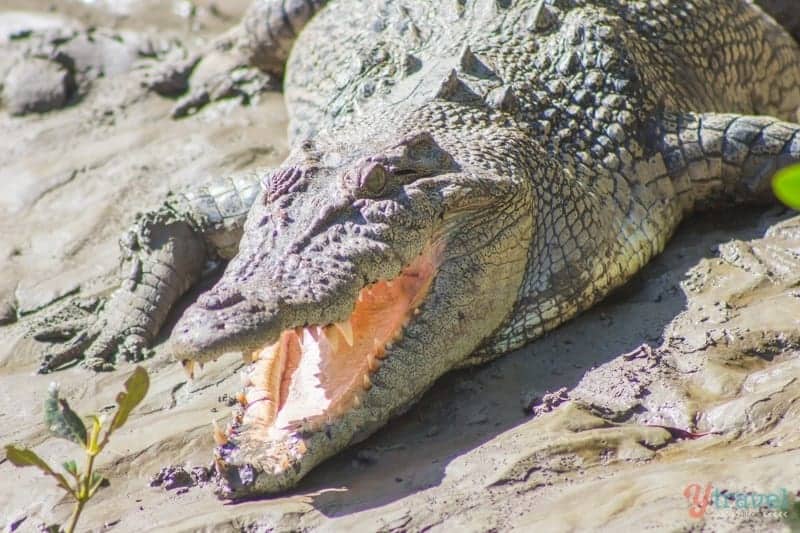
This post may contain affiliate links. We may receive a small commission, at no cost to you, if you make a purchase. Read Disclosure.
The Whitsunday Islands are most synonymous for its pure silica sand so white and powdery it’s like walking through snow, or swimming face to face with bat fish out on the Great Barrier Reef, but there’s a side to the Whitsundays that might surprise you.
The last thing you think of when you think of the Whitsundays are mangroves and silty water so dark and murky you’ll never have a chance of spotting the 4 metre croc holding its breath on the bottom of the river bed, patiently waiting.
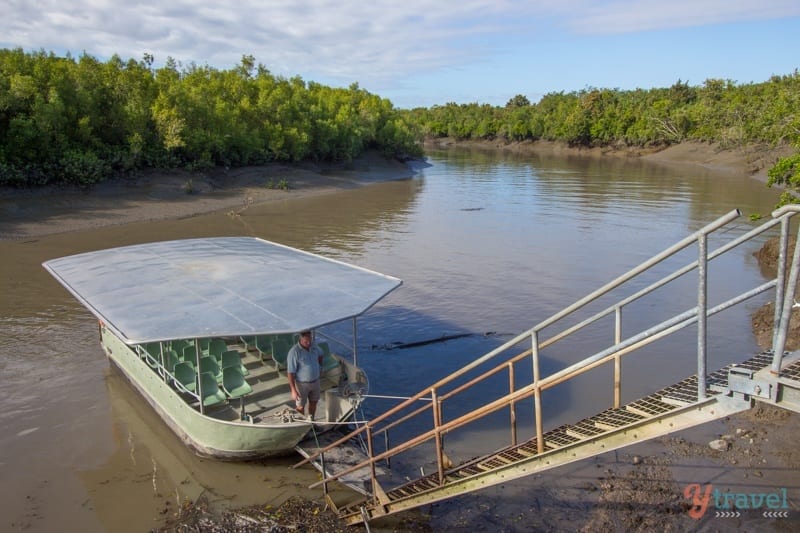
If you want to have a memorable experience that shows the other side to the Great Barrier Reef, then consider a Croc Safari of the wetlands of the Whitsundays.
This is a chance to see crocs up close in their freshwater wetland habitat, and since it connects to the ocean, you can see salties as well as freshies in the estuaries.
For wildlife lovers, this is the experience for you…
The Other Side of the Great Barrier Reef: The Mangrove Forest
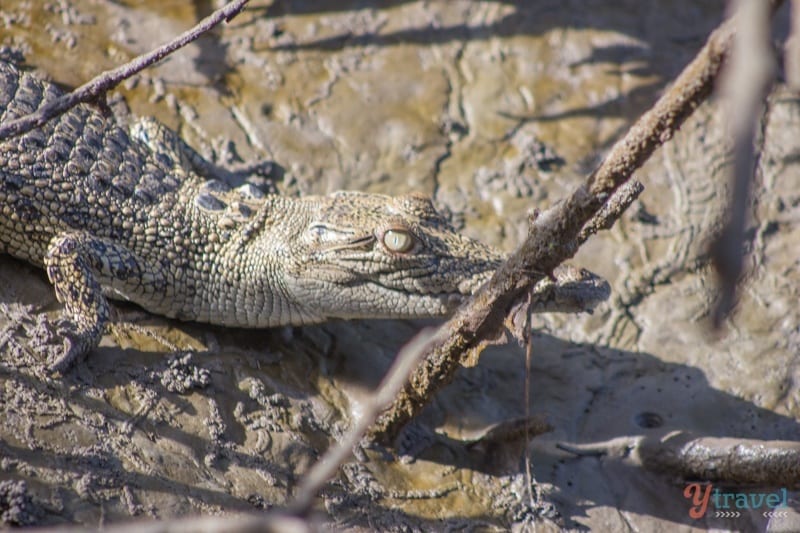 Crocodiles in the Mangroves
Crocodiles in the Mangroves
The mangrove ecosystem is essential for the health of the reef. They trap sediments and absorb extra nutrients, and their complex root systems filter the water before it moves out into the ocean.
The roots slow the movement of tides and cause the sediment to fall to the bottom instead of depositing on the coral as the water moves past it.
The reef in turn buffers the heavy seas, which allow the mangrove forests to grow.
What a loving relationship they have!
Mangroves have never been high on the must-see list. At one stage they were so underrated in Australia they were ripped up and their swampy homes were turned into housing estates and cemeteries, and their natural inhabitants pushed out.
The damage we do when we don’t take the time to understand and appreciate the value every living thing holds…
Now we realise the importance of this unique tropical environment.
It’s like the small flowering plant our croc tour guide, Steve, told us about on the Whitsundays Crocodile Safari on the wetlands out the back of coastal Airlie Beach on the calm waters of Proserpine River.
In South America, there is a small rose coloured flower that are seen to be weeds, but this small little plant actually saves the lives of many in Southeast Asia who suffer the fate of a cobra bite.
Or the sandpaper fig, a flowering tree that many find to be pests growing in their back yards, yet to the indigineous people, it was like the greatest market in town.
They would pick their fruit from the tree, catch their meat by way of bats and possums that made it their home in it, and use the twigs for creating fire, and turn multiple parts of the plant into healing potions.
You see, it’s not just crocodile sightings that Whitsunday Crocodile Safari offers, it’s an educational experience…
Our Experience of a Whitsunday Crocodile Safari Tour
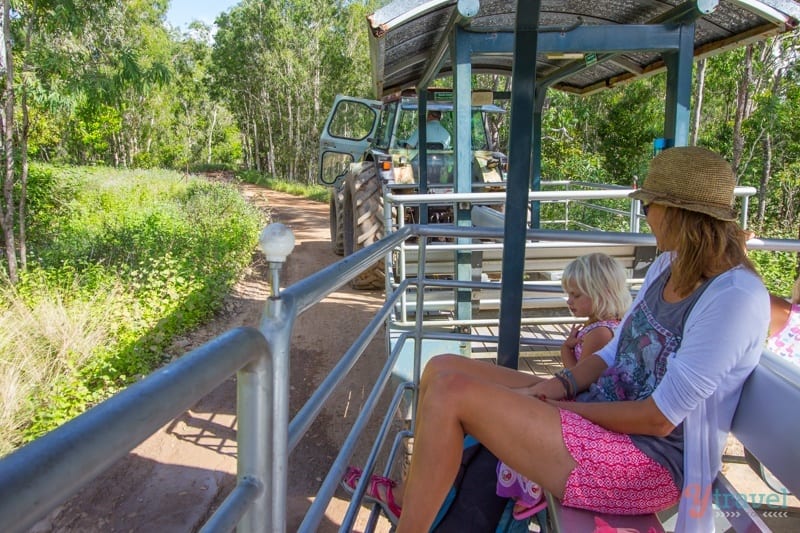
We were driving through the Goorganga plains in a tractor-drawn wagon train as part of the Whitsunday Crocodile Safari tour.
Steve, one of our local experienced guides, stopped as we drove along to talk about the native plants and vegetation growing in the flood plains that have gone under many times in the past 6 years.
It’s thriving ecosystem that many forget to experience, so fixated are they on the coral and sea life of the reef.
A reef that is totally dependent on the wetlands area we were just in.
Earlier that morning we’d spent two hours motoring up and down the Proserpine River on a barge cruise.
It’s one of the healthiest rivers to support croc life on the Eastern seaboard, and the success rate that you will see a croc is about 98% – you can’t beat those odds!
Only the week before we’d had a fabulous education about the crocs at the Koorana Crocodile Farm. Now we were learning all about them in their natural habitat.
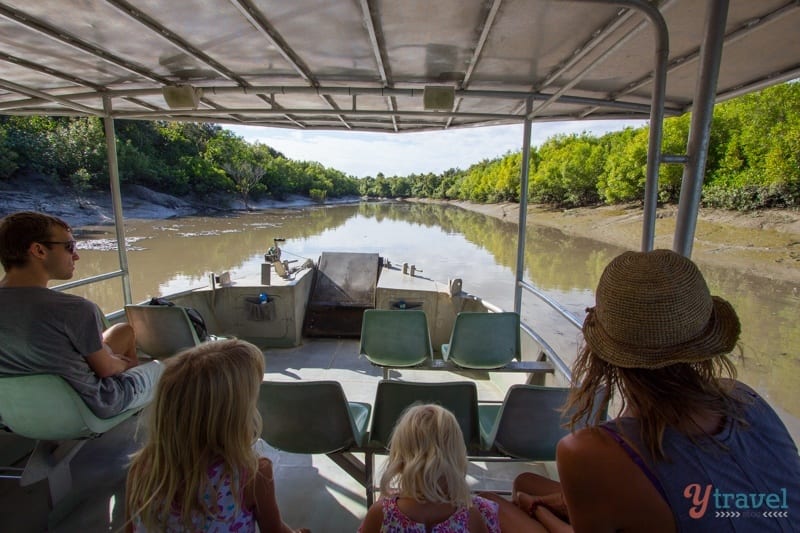
We saw hundreds of baby crocs sitting on the edge of the water on the muddy banks, sunning themselves on logs, or scurrying into the water at the sound of our approach.
Sometimes mum lay close by. Her body stretched out in the mud, her head comfortably down enjoying the warming of her blood.
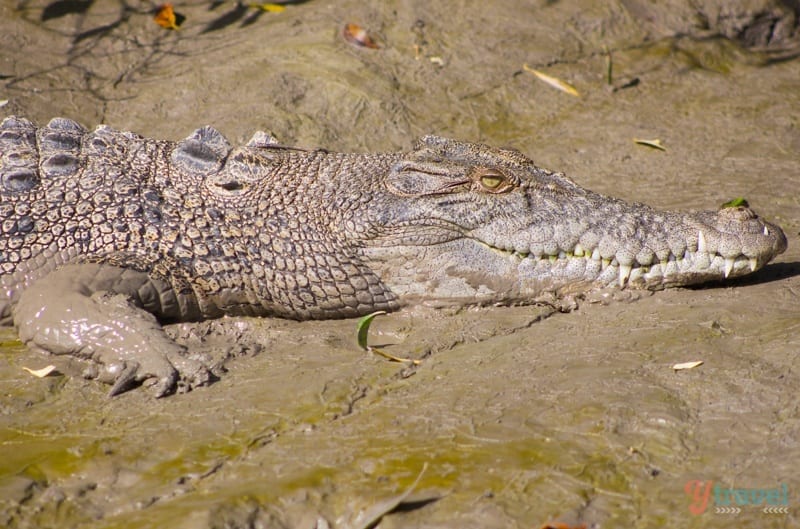
She barely blinked, so comfortable she was with the presence of our boat. Steve’s been running these tours for 20+ years, so the resident crocs know him well and don’t feel threatened by him.
We could get as close as you would want to get in the wild.
Steve told us it was extremely rare for us to see a mother so close to her babies in the wild and they generally abandon them after one month, but many of these little-uns were sticking close to mum even a year on.
The cruise was calming and relaxing, and we saw many migratory birds flying over head and sitting in the trees above the heads of these jurassic mammals, whilst listening to the professional expert commentary from Steve.
As we puttered along on our calm-water cruise, Steve picked out the crocs small and large from afar, calling them by name, baffling us as to how he could even see them, they were so well camouflaged.
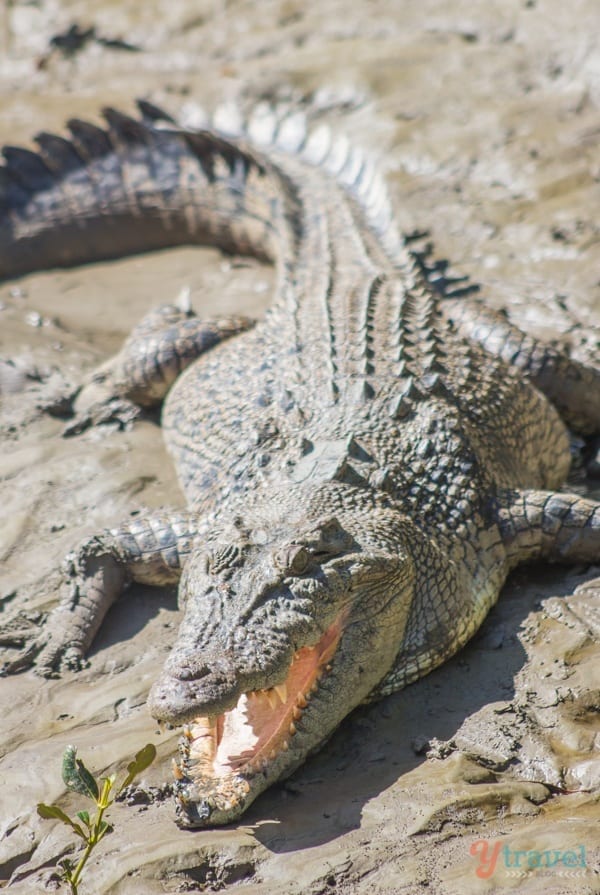
“When you’ve done it as long as me, you know them very well. I can tell each one apart from the other. What you don’t realize is that we’ve passed over about 10 – 12 crocs so far that you haven’t seen.”
Oh that made me feel slightly sick.
Crocodile Safety
Crocs are one of my biggest fears in Australia, especially knowing that my girls are with me. It’s hard to be so alert to make sure they aren’t sticking their hands over the side, or moving around or going anywhere near the edge.
They got the “this is serious” talk from me before we got in the boat. They were to sit in the middle and don’t move.
After Steve’s safety talk about how infested the river was with crocs and going in the water was not a smart idea ever, I think they got the picture.
It’s a shame many other people don’t.
Steve shared with us a few stories of completely stupid people deciding that testing their fate by out swimming the crocs was a fun idea.
One guy was bet $10 by his mate to swim to the other side of the Proserpine River and back. Just to see if he could make it without getting eaten. What an idiot. I wouldn’t even do it for a million.
OR the tourists who had slung their towels over the sign warning people not to swim in the croc infested river, so they could go swim in it.
As Steve said,
“People wonder why they get into trouble with crocodiles. And then idiot people like this cause governments to bring in laws to cull and kill to remove the threat of the monsters!”
He also shared a statistic that more people get killed each year by vending machines than crocs, sharks and snake attacks combined.
Vending machines?? Yep, apparently when people shake them and they fall on them they die. Who knew?
And in 90% of croc deaths, the victims had traces of alcohol in their system.
Not only did I enjoy seeing the crocs in the wild, at a safe distance, I loved the respect and love Steve had for them.
He had a name for each one and could tell us the story and temperament of each croc. There was Fish Lips, Fat Guts, Boof head, Dorothy and Pearl.
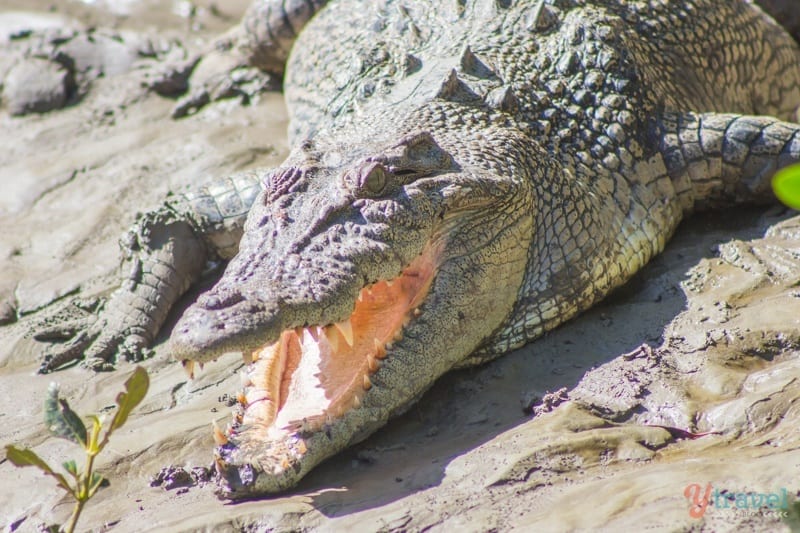
It made me feel a little attached to the crocs and I began to see them with new eyes.
End with good tucker
The Whitsunday Crocodile Safari just doesn’t open up the world of estuarine crocodiles and wetlands for you, it also gives you some mighty good tucker.
In between the boat and the wetlands tour, we had a lovely barbecue lunch of sausages, steak, fish and chicken with lovely salads.
Then at the end of the day, enjoy a mug filled with the unique tastes of traditional billy tea and some damper and honey. Cold drinks are also available. It doesn’t get much more Australian than that. I tell ya, that was some good damper too!
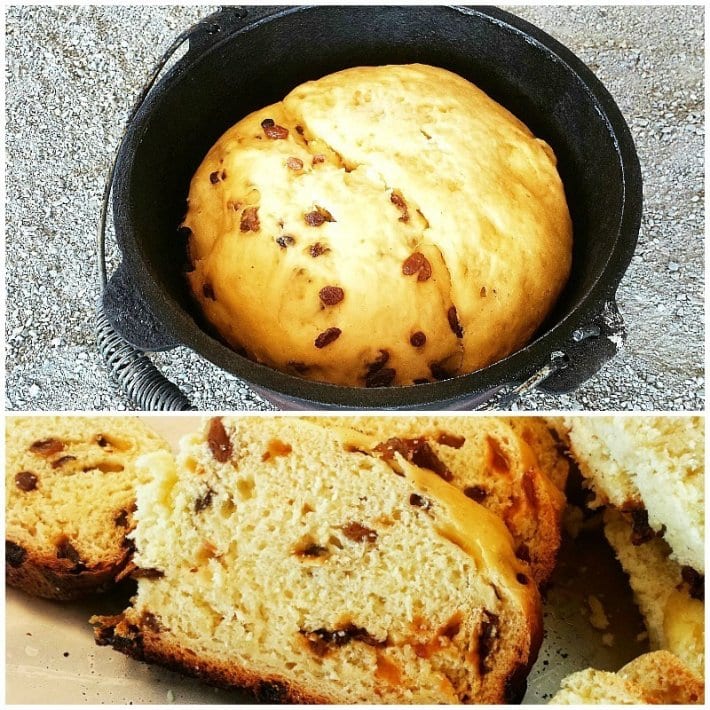
I enjoyed the crocodile safari and seeing a different side of the Whitsundays.
I don’t think you can fully appreciate the reef until you spend time understanding one of the reasons it’s so damn magical.
Go inland for a bit, get to know the wetlands, the mangrove river life, and the beautiful crocodiles that call almost half of Australia their home. It’s a great day out and a memorable nature experience.
Tips for Doing A Whitsunday Crocodile Safari
- Wear closed footwear.
- Bring a jacket for cool and windy days, as it can get pretty cold out on the water.
- Let the tour operator know in advance if you have dietary requirements so they can make accommodations for you.
- Bring a camera with a zoom lens, as many of the crocs are far away and you may need to zoom in a bit.
- Check weather conditions before booking, as you won’t see many marine animals on rainy days.
Whitsunday Crocodile Safari Details
Location: The Proserpine River is a short drive from Airlie Beach in the Whitsundays. Your full-day tour includes return transfers from Airlie Beach.
Tropical North Queensland Travel Tips
Thinking of visiting other parts of tropical North Queensland? Here are some other helpful guides…
Please visit:
Our Sponsor
